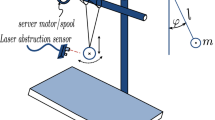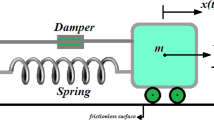Abstract
The motivation of this paper is to update the precise integration method (PIM) by a second-order Taylor formula and make detailed contrasts with the existing PIM, the semi-discretization method (SDM) to exhibit the necessity of developing this improved PIM (IPIM). The dynamics of two-degree of freedom (DOF) milling process with consideration of regeneration effect is first governed by a time periodic delay differential equation (DDE). With time period being evenly divided into a limited set of intervals, the integral non-homogeneous element is approximated by the second-order Taylor formula in every small time segment. After decomposing the exponential factor into a real term with 2N order algorithm, the transition matrix representing the specific machining system state is established in one whole tooth passing period to search for the chatter-free borderline. To investigate the characteristics of the proposed method in convergence rate, prediction accuracy, and computational efficiency, the benchmark example used in the literatures is introduced to develop a battery of comparisons with PIM and SDM. Finally, the experimental verification is also conducted in a CNC machine tool to further confirm the operability of the proposed IPIM, and the results indicate the method is of availability.
Similar content being viewed by others
References
Altintas Y, Budak E (1995) Analytical prediction of stability lobes in milling. CIRP Ann Manuf Technol 44(1):357–362
Ding Y, Zhu L, Zhang X (2010) A full-discretization method for prediction of milling stability. Int J Mach Tools Manuf 50(5):502–509
Merdol S, Altintas Y (2004) Multi frequency solution of chatter stability for low immersion milling. J Manuf Sci E-T ASME 126(3):459–466
Insperger T, Stepan G (2004) Updated semi-discretization method for periodic delay-differential equations with discrete delay. Int J Numer Methods Eng 61(1):117–141
Insperger T, Stepan G, Turi J (2008) On the higher-order semi-discretizations for periodic delayed systems. J Sound Vib 313(1):334–341
Ding Y, Zhu L, Zhang X (2010) Second-order full-discretization method for milling stability prediction. Int J Mach Tools Manuf 50(10):926–932
Guo Q, Sun Y, Jiang Y (2012) On the accurate calculation of milling stability limits using third-order full-discretization method. Int J Mach Tools Manuf 62(1):61–66
Guo Q, Jiang Y, Zhao B (2016) Chatter modeling and stability lobes predicting for non-uniform helix tools. Int J Adv Manuf Technol 87(1–4):251–266
Insperger T (2010) Full-discretization and semi-discretization for milling stability prediction: some comments. Int J Mach Tools Manuf 50(7):658–662
Li M, Zhang G, Huang Y (2013) Complete discretization scheme for milling stability prediction. Nonlinear Dynam 71(1–2):187–199
Xie Q (2016) Milling stability prediction using an improved complete discretization method. Int J Adv Manuf Technol 83(5–8):815–821
Li Z, Yang Z, Peng Y (2016) Prediction of chatter stability for milling process using Runge-Kutta-based complete discretization method. Int J Adv Manuf Technol 86(1–4):943–952
Ding Y, Zhu LM, Zhang X, Ding H (2011) On a numerical method for simultaneous prediction of stability and surface location error in low radial immersion milling. J Dyn Syst-T ASME 133(2):024503
Zhang X, Xiong C, Ding Y (2016) Prediction of chatter stability in high speed milling using the numerical differentiation method. Int J Adv Manuf Technol 89(9–12):1–10
Balachandran B (2001) Nonlinear dynamics of milling processes. Philos T Royal Soc A 359(1781):793–819
Long X, Balachandran B (2007) Stability analysis for milling process. Nonlinear Dynam 49(3):349–359
Long X, Balachandran B (2010) Stability of up-milling and down-milling operations with variable spindle speed. J Vib Control 16(7–8):1151–1168
Sims N (2016) Fast chatter stability prediction for variable helix milling tools. P I Mech Eng C-J Mec 230(1):133–144
Grossi N, Montevecchi F, Sallese L (2017) Chatter stability prediction for high-speed milling through a novel experimental-analytical approach. Int J Adv Manuf Technol 89(9–12):2587–2601
Li Z, Wang Z, Shi X (2017) Fast prediction of chatter stability lobe diagram for milling process using frequency response function or modal parameters. Int J Adv Manuf Technol 89(9–12):2603–2612
Dai Y, Li H, Hao B (2018) An improved full-discretization method for chatter stability prediction. Int J Adv Manuf Technol 96(9–12):3503–3510
Yan Z, Wang X, Liu Z (2017) Third-order updated full-discretization method for milling stability prediction. Int J Adv Manuf Technol 92(5–8):2299–2309
Tang X, Peng F, Rong Y (2017) Accurate and efficient prediction of milling stability with updated full-discretization method. Int J Adv Manuf Technol 88(9–12):1–12
Dai Y, Li H, Xing X, Hao B (2018) Prediction of chatter stability for milling process using precise integration method. Precis Eng 52:152–157
Janez G, Martin K, Klaus W (2004) Mechanistic identification of specific force coefficients for a general end mill. Int J Mach Tools Manuf 44(4):401–414
Dai Y, Li H, Wei Z, Zhang H (2018) Chatter stability prediction for five-axis ball end milling with precise integration method. J Manuf Process 32:20–31
Funding
This work received financial support from the National Natural Science Foundation of China (51575075) and Collaborative Innovation Center of Major Machine Manufacturing in Liaoning.
Author information
Authors and Affiliations
Corresponding author
Rights and permissions
About this article
Cite this article
Li, H., Dai, Y. & Fan, Z. Improved precise integration method for chatter stability prediction of two-DOF milling system. Int J Adv Manuf Technol 101, 1235–1246 (2019). https://doi.org/10.1007/s00170-018-2981-y
Received:
Accepted:
Published:
Issue Date:
DOI: https://doi.org/10.1007/s00170-018-2981-y




